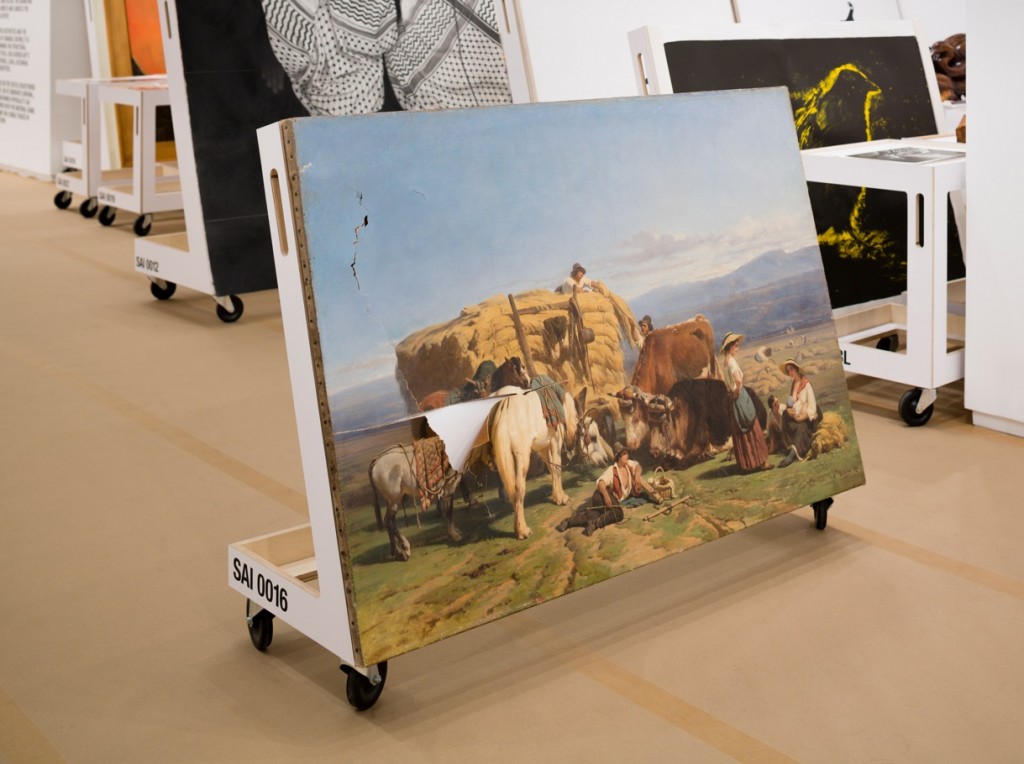What Have We Lost? by Kellie Lanham
“At the tiny Newman Popiashvili gallery, steps below the street, the scum line ran right through the paintings that still hung on the wall. A woman standing in the gloom cried when asked whether the gallery had insurance.”[1]On a Tuesday afternoon in late October, lower Manhattan art dealers entered their gallery spaces to assess the damage of Hurricane Sandy. What they found were storage basements filled with water containing artwork submerged, torn and destroyed from the hurricane’s unforgiving trajectory. The area most affected is New York’s elite gallery block in Chelsea – West of 10th and South of 23rd. Big names like Sonnabend and Gagosian line these streets alongside posh retailers such as Balenciaga and Comme des Garçons. It is clear that this is “where one-percent money comes to play.”[2] As reports came in about the artwork casualties, it is not surprising that the loss was felt more fiscally, rather then culturally. The New York Times and New York Magazine were littered with articles discussing insurance policies, money lost, and the need to sell. We are once again reminded that these aren’t institutions of culture, but rather of business. What is hung on the wall is not as important as how fast they can get it out the door. As dealers assess the damage of artwork in inches of water damage, perhaps we as art spectators should take this opportunity to consider two things: 1) Did the storm bring about a cultural loss? 2) Does a work of art lose all its significance – fiscal and cultural – once it is physically “damaged?” The contention between the notion of art as commodity and art as a critical/societal entity has been examined endlessly, and the commercial gallery has long been the site of this dispute. The aftermath of and response to the hurricane made it very clear that the loss of the galleries “commodities” was of utmost importance; leaving the loss of artworks cultural significance to be measured later. However, we need to consider, what was actually lost? The artworks still exist, but with some physical changes. If we are assuming the artwork only has value as long as it retains the identical physical appearance as when the artist first created it, let’s recall Marcel Duchmap’s The Bride Stripped Bare by Her Bachelors, Even (The Large Glass). The large painting on glass was broken in route between institutions; the artist liked the aesthetic quality of the shattered glass so much he deemed the artwork complete. This art historical anecdote allows us to reconsider the conventional notion of art as a perfect and unchanging object. In fact, Duchamp allows us to see an accidental or unintended change in the work to be admired, rather then understood as evidence of “damage.” We can apply this rational to the works of art altered in Sandy. Simply because a painting has watermarks does not mean is ceases to exist as an emotive and societally charged artifact. In fact, a work that reflects the damage of a major tragedy – such as a devastating hurricane – could be argued to hold more significance to this culturally moment. Rather then cast off this work as being ruined, perhaps it should be venerated for its endurance through social change. The damaged piece not only holds the original cultural significance, but also a physical mark of its history. SAI 0016 ( La Moisson, by Alexandre Dubuisson) in No Longer Art: Salvage Art Institute, Arthur Ross Architecture Gallery, Columbia University, photo by James Ewing In a completely unforeseeable coincidence, the Arthur Ross Architecture Gallery at Columbia University opened the exhibition No Longer Art: Salvage Art Institute almost immediately after the hurricane’s wrath (the show was originally scheduled to open November 7th, but was postponed until November 14th). This exhibition, just five miles north of Chelsea, displays work from the Salvage Art Institute – artist, Elka Krajewska’s growing collection of marginalized artwork. Established in 2009, SAI collects damaged works of art that are so heavily impaired insurance companies have deemed them “non-art” or having “total loss” status.[3] In Arthur Ross, fragments of a Koons Balloon Dog are placed alongside a ripped 19th century French painting; transcending the classifications of medium or genre, the exhibition simply considers what value does a “damaged” work still hold. Through the eyes of the financier these objects are completely devoid of any fiscal or social worth, but in placing them back into the gallery system No Longer Art proves their aesthetic and social value can be revived. The exhibition gives us the opportunity to look through and between the regulations of art value. Through considering salvaged art, we find that we did not lose any cultural artifacts in the storm, but rather altered them. Whether the work in those affected Chelsea galleries are mended to their original form or are disregarded as an investment lost, we cannot strip them of their cultural worth. While Hurricane Sandy washed away the material perfection of some cherished artworks, it also opened up a space for us the rethink the fragile pedestal we put these works on.
[1] Benjamin Wallace, “The Sinking of 22nd Street: Art and Commerce Underwater,” New York Magazine, November 4, 2012, accessed December 1, 2012, http://nymag.com/news/features/hurricane-sandy-art-galleries-2012-11/ [2] “Damage: No Longer Art: Salvage Art Institute,” accessed December1, 2012, http://events.gsapp.org/event/damage-no-longer-art-salvage-art-institute [3] Ibid.
|
